Fiber optic cable has been extensively used in the telecommunication industry due to its immunity to electromagnetic interference, ease of installation and high bandwidth over long distances. The types of fiber optic cables, therefore, can be various. Since different types are for different applications and environments, knowing the feature and distinction of each one would help you to choose the best one for your specific infrastructure. In this article, we will introduce five types of fiber optic cable: indoor fiber cable, outdoor fiber cable, aerial/self-supporting fiber cable, direct-buried fiber cable and submarine fiber cable.
1. Indoor Fiber Cable
Simplex Fiber Cables
Simplex cables are one fiber, tight-buffered (coated with a 900 micron buffer over the primary buffer coating) with kevlar (aramid fiber) strength members and jacketed for indoor use. Simplex cable varieties include 1.6mm & 3mm jacket sizes. These types are used mostly for patch cord and backplane applications.
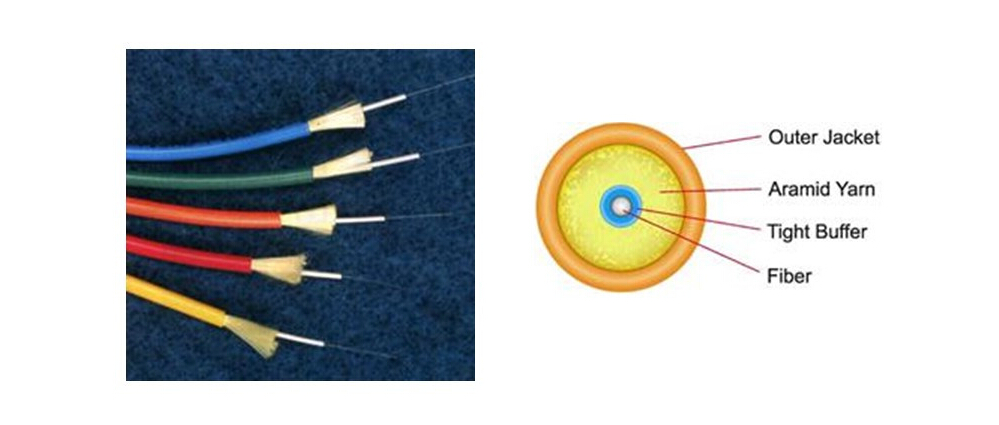
Duplex Fiber Cables
Duplex-zip fiber cable contains two optical fibers in a single cable structure, simply by joining two of them with a thin web. Light is not coupled between the two fibers, typically one fiber is used to transmit signals in one direction and the other receives. Besides being used for patch cord and backplane applications, it can also be employed at desktop connections.
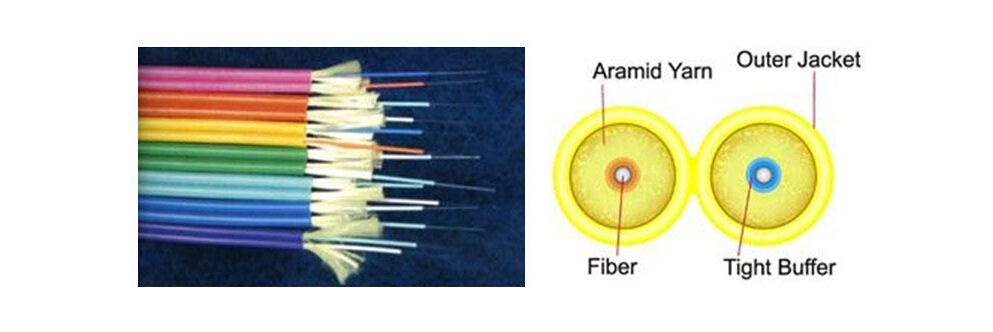
Distribution Fiber Cables
Distribution fiber cable is the most popular indoor cable, as it is small in size and light in weight. This compact building cable consists of individual 900um buffered fiber, connectors may be installed directly on 900um buffered fiber at breakout box location. These cables are used for short, dry conduit runs, riser and plenum applications. The fibers are double buffered and can be directly terminated, but because their fibers are not individually reinforced, these cables need to be broken out with a "breakout box" or terminated inside a patch panel or junction box to protect individual fibers.
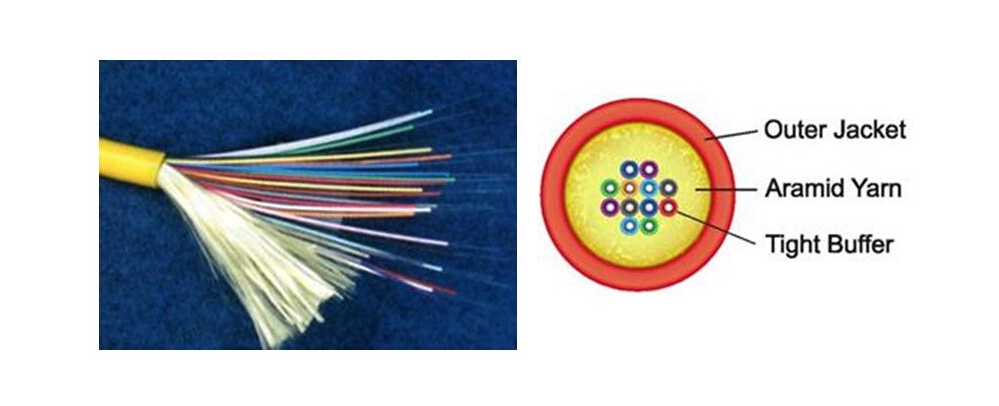
Breakout Fiber Cables
Breakout fiber cables are also called fan-out cables. They are made of several simplex cables bundled together inside a common jacket. Breakout cable is a favorite where rugged cables are desirable, or direct termination without junction boxes, patch panels or other hardware is needed. It is suitable for conduit runs, riser and plenum applications. Because each fiber is individually reinforced, this design allows for quick termination to connectors and does not require patch panels or boxes. Breakout cable can be more economical where fiber count isn't too large and distances too long.
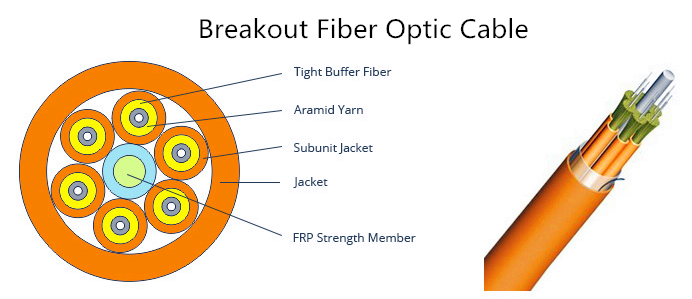
Ribbon Fiber Cables
Consists of up to 12 fibers contained side by side within a single jacket. Ribbon fiber cable is preferred where high fiber counts and small diameter cables are needed. This cable has the most fibers in the smallest cable but with the lowest cost. Since all the fibers are laid out in rows in ribbons, typically of 12 fibers, the ribbons are laid on top of each other. Another advantage of ribbon cable is mass fusion splicers can join a ribbon (12 fibers) at once, making installation fast and easy. It is usually adopted in network applications and data centers.
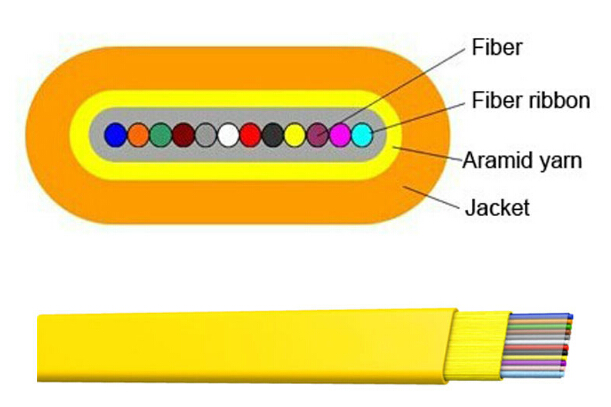
LSZH Fiber Cables
LSZH refers to low smoke zero halogen cables, they are offered as an alternative to halogen-free applications. Less toxic and slower to ignite, they are a good choice for many internal installations. This cable may be run through risers directly to a convenient network or splicing closet for interconnection.
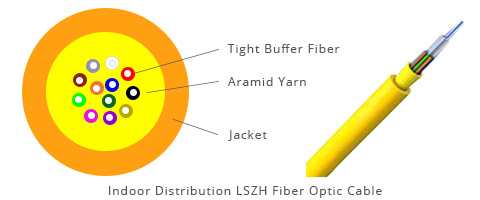
2.Outdoor Fiber Cable
Indoor/outdoor Tight Buffered Fiber Cables
Indoor/outdoor rated tight buffered cables have riser and plenum rated versions. These cables are flexible, easy to handle and simple to install. Since they do not use gel, the connectors can be terminated directly onto the 900um fiber without difficult-to-use kits. This provides an easy and overall less expensive installation.

Outdoor Loose Tube Fiber Cables
Loose tube cables are the most widely used cables for outside plant trunks because it offers the best protection for the fibers under high pulling tensions and can be easily protected from moisture with water-blocking gel or tapes.These cables are composed of several fibers together inside a small plastic tube, which are in turn wound around a central strength member, surrounded by aramid strength members and jacketed, providing a small, high fiber count cable.
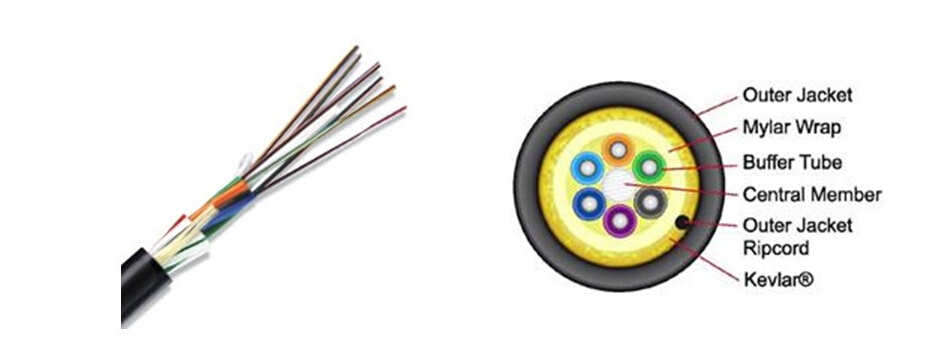
Loose tube cables with single-mode fibers are generally terminated by spicing pigtails onto the fibers and protecting them in a splice closure. Multimode loose tube cables can be terminated directly by installing a breakout kit, also called a furcation or fan-out kit, which sleeves each fiber for protection.
3.Aerial/Self-supporting Fiber Cable
Known as figure 8 fiber cables as well, this type is designed to be strung from poles outdoors and most can also be installed in underground ducts. It can be lashed to a messenger or another cable (common in CATV) or have metal or aramid strength members to make them self supporting. Aerial fiber cable is easy to install, thus saves a lot of time and cost. Notice that it must be grounded properly.

4.Direct-buried Fiber Cable
Armored fiber cable is used in direct buried outside plant applications where a rugged cable is needed and/or rodent resistance. Similar to outdoor cables but with an outer armor layer for mechanical protection. It withstands crush loads thus can be employed at direct burial applications, or in data centers where cables are installed underfloor, or installed in dusts and aerially. Armored cable is conductive, so it must be grounded properly.
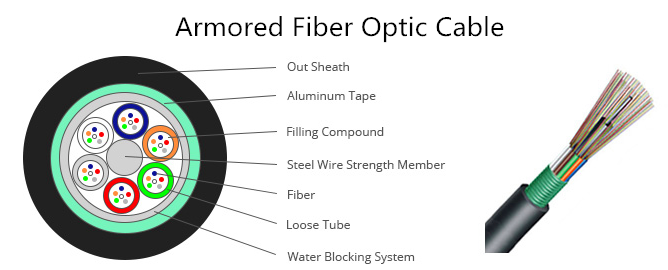
5.Submarine Fiber Cable
Submarine fiber cables are used in fresh or salt water. To protect them from damage by fishing trawlers and boat anchors they have elaborately designed structures and armors. Long distance submarine cables are especially complex designed.
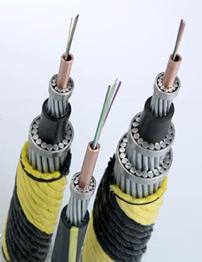
Conclusion
As we know, different types of fiber optic cables are of distinct designs and constructions, thus for different applications and environments. What we introduced above are several commonly used fiber optic cables, hope it would offer you some help to find the most suitable one.

No comments:
Post a Comment